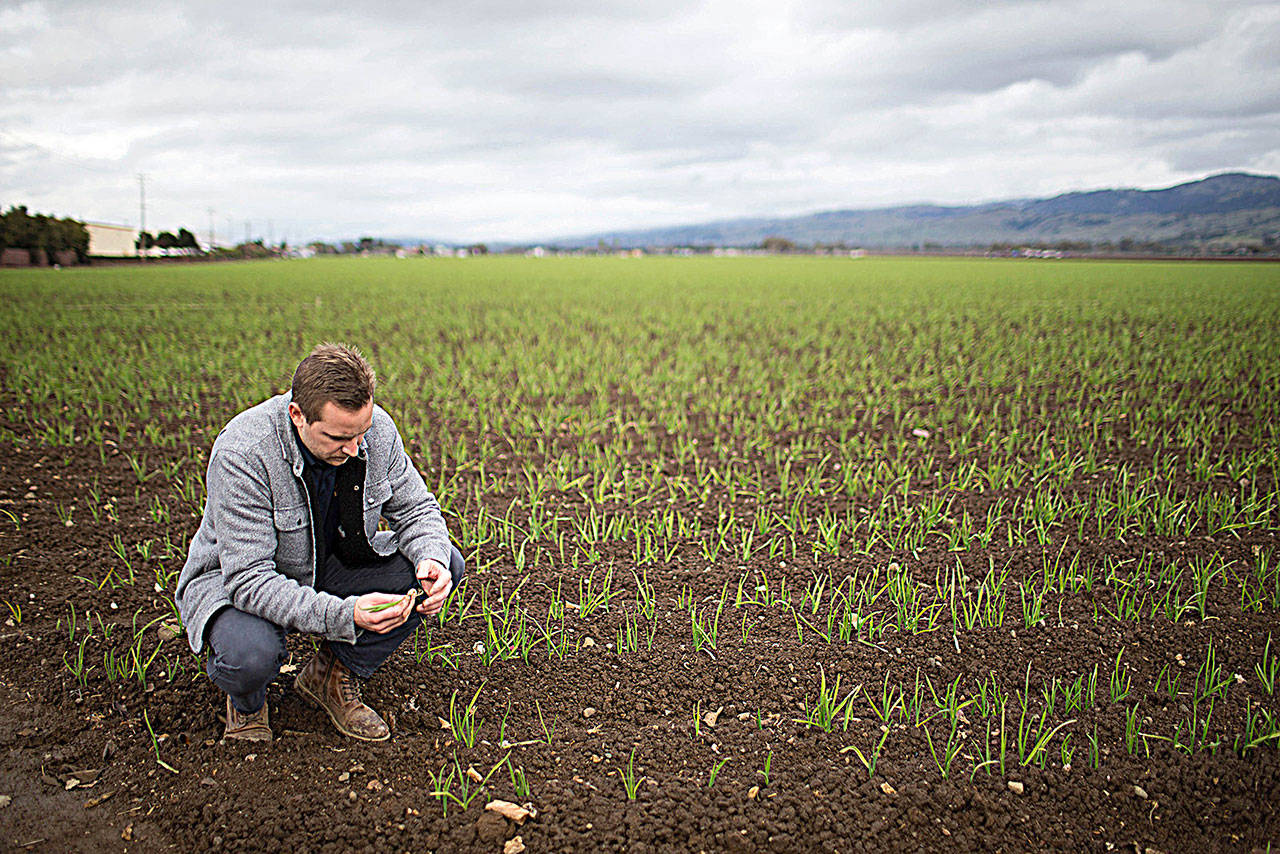By Lisa M. Krieger
The Mercury News
GILROY, Calif. — California farmers hate President Donald Trump’s tariffs. Except maybe one.
Since President Donald Trump imposed a 10 percent tariff on Chinese garlic and other imports, sales have surged for Gilroy’s Christopher Ranch — America’s largest producer of fresh garlic.
This past week, the ranch has had so many orders that it’s adding overtime work shifts to clean, trim, crack, sort, peel, box and ship the 50,000 extra pounds of premium “California White” bulbs, pulled out of cold storage. Last year, with the market awash with low-price Chinese imports, sales were in a funk.
The turnaround eases years of angst for the ranch in Gilroy, once named “The Garlic Capital of the World.”
“We’re running at capacity,” said Ken Christopher, 33, a third-generation grower at the 60-year-old business.
In the rest of the state, farmers who grow other crops such as cotton, walnuts, almonds and grapes are hurting.
The trade war started June 15, with Trump’s decision to impose tariffs on subsidized Chinese steel and aluminum. China responded by imposing $60 billion in tariffs on U.S. goods, targeting many California-grown products like wine, walnuts, honey and olive oil.
Almost all of Christopher Ranch’s garlic gets sold in the U.S. So when the American market was flooded in recent years with cheaper garlic from China, the local product’s prices were undercut. The new 15 percent tariff raises the price of Chinese garlic.
But many of California’s other crops, in contrast, are exported. All of our cotton is sold overseas. About two-thirds of almonds and 40 percent of walnuts also are sold abroad.
When China responded with its own set of retaliatory tariffs, these products were suddenly more expensive. Chinese suppliers started buying from other nations instead.
It’s been a tumultuous time for Livermore-based vintner Wente Family Estates, which has exported wines to China for 23 years. The winery has not shipped a single bottle of wine to the Chinese mainland this year, said Michael Parr, vice president for international sales. Importers in China don’t want to pay the 15 percent tariff on that wine, on top of a pre-existing 48 percent charge for taxes and other tariffs.
The California Cotton Ginners and Growers Association’s Roger Isom describes the increased tariffs as “devastating,” with contracts being canceled.
California’s cut-flower business was looking to expand in China, but instead will focus on growing markets like Japan, Canada and South Korea, according to the California Farm Bureau Federation. Some of California’s 30 timber companies also report canceled sales. But because wood is not perishable and can be stored, companies can hold onto their product.
About 3,000 California farmers will apply for the federal Market Facilitation Program, which provides relief to growers hit by tariffs, reports the state’s Farm Bureau.
Despite the short-term benefits for garlic, Christopher concedes that tariffs are not a permanent solution.
“In broad macroeconomic terms, we recognize that an escalating trade war may not be in the nation’s larger economic interest,” he said. “But immediate relief for the U.S. garlic industry is needed.”
American farmers faced growing competition as China moved away from growing bulk commodities like corn, wheat, and soybeans and into specialized higher-value crops like garlic, subsidized by the government.
In the early 1990s, U.S trade officials found that the Chinese were “dumping” the garlic, selling it at prices below production costs. U.S. Customs officials issued an anti-dumping order and imposed a stiff tariff on importers.
“The anti-dumping dues have been a very effective tool in blocking most of the Chinese garlic coming into the market,” said Adams Lee, an international trade and regulatory lawyer with the Seattle firm Harris Bricken. “That’s the only way that Christopher Ranch and other U.S. growers are able to survive.”
“Unlike most agricultural producers in California, garlic is one of the unique industries which has grown to depend on the trade barriers that they have asked the U.S. government to impose,” he said.
But a 2016 General Accounting Office report showed that some exporters found a way around the duties, closing before paying them. Garlic exporters owe the U.S. more than $600 million in billed-but-uncollected duties.
Here in Gilroy, garlic farmers left long ago for the Central and San Joaquin valleys. In the past three decades, nine of 12 U.S. garlic growers have gone out of business.
Times got particularly tough at the end of 2017, when the wholesale price of Chinese garlic plunged to $15 a box. California garlic costs $60 a box.
Christopher Ranch lost a contract with the East Coast division of Safeway, a valued customer. The timing was terrible, because the ranch’s expenses had grown due to an increase in entry-level wages from $11 to $15 an hour.
With the new tariffs, Chinese garlic now costs $40 a box. And the tariff is impossible to evade.
“Every increase firms up the cost once it lands in the U.S.,” said Louis Hymel of Coalinga garlic grower Spice World, which has seen a minor, not major, boost in sales.
In December, Christopher Ranch had its best garlic shipping week in company history. Now sales are where they were two years ago.
More is needed to correct a long-standing injustice, Christopher said. If the trade war escalates, tariffs on garlic could be raised to 25 percent, and Christopher is ready to seize the opportunity.
“We’re fully prepared to expand acreage, invest in more machinery, invest in more storage space and increase our workforce,” he said.



